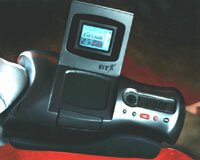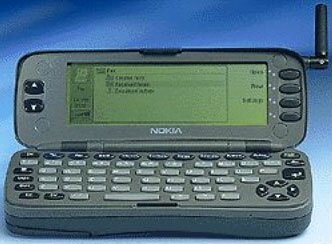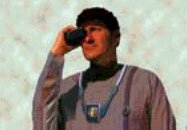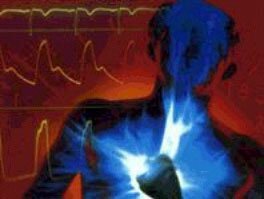Preprints & Reprints
Back to Preprints & Reprints > Publications & Opinion > Homepage
FROM KIRK TO PICARD (A Vision of mobility)
Peter Cochrane, Roger Payne, Brian MacDonald
The Dream
If ever there was a dream of full mobile communication it was fuelled by the Tuesday night experiences of UK students in the 1960s. Tuesday nights were special, dorms would be packed and full of anticipation, people waiting to see James T Kirk beam down to some unknown planet. His first act was always to confirm his safe arrival through his flip top communicator. This remarkable device seemed both convincing and far fetched at the same time. Captain Kirk would occasionally have to resort to the twist of a rotary knob to fine tune and avoid static on what was clearly an analogue device. At that time the mobile radios of the military, police force, emergency services and cabs still used thermionic tubes and were the size of a small briefcase. So, what Captain Kirk had was barely believable.
Thirty years later Jean-Luc Picard merely wears a badge, and a stroke of the hand is all it takes to contact anyone or anything of choice. Communication is always clear and concise, no numbers to remember, no directories, buttons to push, knobs to adjust or operators to interface with. It is obviously a digital device in it's precision, and above all, it is very easy and natural to use, no training courses or handbooks necessary.
Chocolate Bars
This dream is now much closer; today we have cellular mobile phones the size of a chocolate bars that cost almost nothing, and networks that cover over 90% of all the major countries in the developed world. But remember, only a decade ago, the first cellular phones were the size of a small briefcase and very heavy. The so called pocket phones were also very heavy and resembled a house brick. So perhaps we are catching up with the future, and may even overtake it, with wearable devices of even greater capability than those of Star Trek on the horizon.
Among the smallest devices currently available are Dick Tracy style wrist phones, as well as some announced to be jewellery like, and worn as a part of clothing. In all of this the primary physical limitations to size are power (batteries), keyboard and display - in that order. The other key limitations are dominated by usability. Background acoustic noise, cell coverage, and chaotic demand for access coupled with multi-function displays and buttons all add to users operating difficulty. Buttons with 4 or 5 functions are not uncommon in the race to reduce size and price, whilst simultaneously improving reliability and the number of facilities. There is also the assumed microphone-to-ear distance of half that of a human head, which often seems to demand unnatural acts in terms of just making contact and talking.

Fig 1: Prototype wrist worn communicator
Cables & Connectors
In Europe the GSM system provides a near 100% roaming ability with speech and 9.6kbit/s data connections the norm. Connecting a lap top, organiser, camera or other device into Internet or an Intranet is no longer a problem. In fact - this article comes to you direct from the Ipswich to London Inter-city train at over 90mph, and it could just as well have been transmitted from a car, cab or coffee shop. The inconvenience is; the separate devices, connecting cable, limited power capacity size and weight. Despite the fact that lap tops have modems built in, and soon the entire digital phone will also be integrated into the one device, this problem is becoming extreme. As a result we may soon have a species of human with longer arms and shorter sight. However, the first products to partially reverse this trend are now combining pocket organisers and mobile telephones.

Fig 2: A back-to-back GSM phone and pocket organiser
More Moore
We can expect Moore's Law to continue with chip capacity doubling at 18 month intervals. For the next decade the technology already exists, and chances are that this trend is set to continue for the decade after. So computers will become at least 1000 times more powerful in the next decade or so, and combined mobile phones and modems will be built into a single chip. But there are more fundamentally influential technology changes afoot. Firstly; there is voice command and control, that will, to a great extent, do away with the need for both keyboard and mouse. It may also get rid of the screen for many applications. Secondly; there are new display technologies that could change the entire nature of the interface and the box. Thirdly, there is the nature of networking and where we are going to locate the intelligence in future. Most likely, machine intelligence will be everywhere - we will carry some, and networks will provide us with the rest. In the forefront of this revolution today is the new programming language Java with its Applets on demand. This relies on networks that are ubiquitous, reliable and low cost. In the time frame of development and deployment this has to be the telephone network - it is all we have. So what will we be able to do - what kind of terminals could be engineered in the short and long term?
It Would be Nice to Talk
Voice command and control will reduce or eradicate the need for a keyboard and mouse for many applications. It is already possible to talk to a machine to gain directory advice and buy and sell goods. However, background acoustic noise from cars, trains and people is a major limiter. The use of lightweight noise cancelling headsets is an obvious and long awaited addition to the mobile phone for all those who like to drive, ride, walk and talk. But then there are other possibilities, such as adaptive noise cancellation using one ore more microphones, with single and multiple phased speakers adapting to create acoustic bubbles. Active feedback acoustic (howl around) suppression, and constant sound level relative to background noise is also possible to negate the variation due to our head position and location. So the Jean-Luc badge communicator is now a laboratory demonstrator and a feasible product that could revolutionise both price and applications.
Straight in The Eye
Display technologies are so dominated by the TV and CRT (Cathode ray Tube) paradigm it is hard to break free. But why use an electron gun to write on a phosphor coating that emits photons that hit the retina of our eye. Why not fire photons straight into the eye. We now have lasers - we are no longer limited by the CRT or LCD. Why not take over the retina by direct illumination rather than the limited window of a conventional screen. Whilst we cannot, yet, mount a laser on a contact lens, as it is currently precluded by the device line width necessary, it is possible to mount lasers on spectacle frame to give a head up display. Combine this with an ear mounted device for audio and the near cyborg communicator is born.

Fig 3: Combine head-up display and acoustic head-set
So what other functions might we desire in our new mobile world? Well we could have Radio, TV, information services, and of course Email and WWW access. But there is more. A GPS (Global Positioning) receiver can be added to give precise location and navigational pictures and information directly to eye and ear. Ultimately we might expect everything in the information world direct to our head - just by asking.
Thinking Networks
Mobile computing will also see a revolution by virtue of network-centric intelligence and applications. But again, an acceptable natural language, spoken word command and control will soon be available which in turn will improve usability whilst reducing overall cost. The primary attraction of such a box is likely to be the ubiquitous, general and easy access to everything, anywhere, anytime, in any form. When coupled with an interface much simpler than a VHS machine, such a box will see an extended market of people previously frozen out of the information world by the complexity of the PC. Some estimates put this underprivileged majority as high as 80% of the population - it is a huge potential market. Users will also see the advantage of continual software updates at low cost over the network. This should break the unusual paradigm and experience of being sold a continual stream of upgrades to products that never actually worked fully when first purchased.
Who Wears Whom?
For the more powerful mobile computers and terminals there are applications in sectors such as medicine, engineering, insurance and plant maintenance. For example, in recent experiments Nurse Practitioners have been able to bring the expertise of GPs to bear at remote sites. Even with a standard GSM phone, lap top, and miniature TV cameras it is possible to complete dermatalogical examinations, foetal scanning, remote diagnosis, minor operations. Emergency ambulance paramedic support from hospitals to the point of need has also proved possible with similar equipment.
Probably the most revolutionary move will be towards the wearing of this technology. Just like the carriage clock of 300 years ago that became a pocket watch, and then a wrist watch, the cameras, computers and communicators can all be worn as items of clothing, jewellery and body furniture. So everything from roving news and sports reporting, to precise surgery and insurance loss adjusting can be done with a minimal amount of technology.

Fig 4: The eye phone - a wearable voice and vision communicator
As the machines and networks become increasingly intelligent, prolific, and co-operative, there will be a growing artificial intelligence on tap. Access to a super computer from a wearable unit is feasible, and would give a user an immense capability. We might therefore anticipate wearable units tapping into information and computing networks comparable to, and in some respects, exceeding our own limited human capabilities.
Power
Throughout all of these possibilities there is one underlying limitation - power! Whilst the power required will fundamentally reduce as the integrated circuits and functions are optimised, the radio transmitter will still demand about 0.5W. But it is important to remember that the transmit power is a function of distance. If cell sizes are reduced drastically then so can the transmit power and overall consumption. If every streetlight and building was a wireless hub capable of transmitting and receiving, then mobile units could be reduced to 50mW output and run on a single AA battery for days. Optical wireless down-links could also be used to give enhanced facilities by providing very wide bandwidth, capable of carrying real-time video. The idea of micro-cells is ably demonstrated by DECT systems that offer 8.5 hours continuous transmission time with up to 1000 hours standby. We should also remember that future chip integration will reduce power consumption still further. So, in the worst case, a reasonable estimate for the total power demand for a combined computer -communicator is <2.5W. If we add a screen, this can be doubled by the need to backlight. For head mounted displays we may only require <0.25W.
Body Heat
All of the above already exists in the research phase somewhere. The single most neglected technology in all of this is power - batteries and charging. Nothing much is being done in industry - and we are coming to the end of the road. Assuming we could get away with 5W as an average, then the best results for a thermal vest - torso heat to electricity conversion - is <1W. As for kinetic energy - walking and swinging your arms and legs - it is <2W. In both cases these solutions mean being wired into your clothes, and do not justify the discomfort and inconvenience. It is still better to carry a bag full of batteries. So a programme on new materials and energy storage or generation may be required to realise a really mobile future.
Caring Technology
In many countries over 2% of the population are diabetic, and even more are on other forms of drug treatment. Ideally these people require constant monitoring and care to meet their needs and represent a significant work load for health care systems. As technology extends our longevity, and as the birth rate declines, we face a future of increasing numbers of dependent people, and a diminishing number of carers. In the 21st century, providing the level of care that we enjoy today will be inconceivable. We will have an older population and far fewer people working and creating wealth, so some new technological solutions will be necessary.
With future wearable electronics it is feasible that the fundamental monitoring of heart, respiration, blood pressure, skin, salinity and blood glucose and other characteristics can be provided in real time. Such features could become a part of the office you wear/mobile communicator. Algorithms that maintain the right balance of insulin through an artificial pancreas or drug balance through automatic dispensers could be linked directly to the hospital. Why occupy ward space just so you can be monitored by machines? It can all be done remotely. But it does not stop here, what about the technology that wears us? The number of internal body part replacements is accelerating and they are increasingly electronic, or mechatronic in form. It is quite inconceivable that we should give an office copying machines the intelligence to call for help when they are about to fail and yet neglect the pace maker or artificial heart on which so many people are dependent for their very existence.

Fig 5: Mobile biometric monitoring - with wearable technology
Chaos
Many people equate chaos to randomness, but they are very different. Chaotic systems exhibit patterns that can be near cyclic in manner that are often difficult for us to perceive. Random systems on the other hand are totally unpredictable. This was the dominant mode of the telephone system just 20 years ago when all telephones were static and connected to a copper wire line. Users made an average of 2 or 3 calls per day at unrelated times. There were busy hours, meal times and tea breaks that would see a distinct lack of calls, but by and large calls were prompted by random events. This changed with the arrival of TV phone in programme. Someone singing a song on TV could result in half a million people telephoning London to cast votes for their local hero in the space of 15 minutes. A new world of network chaos was born.
With the arrival of the mobile telephone a new phase of chaos erupted. Traffic jams, train and plane cancellations all trigger correlated activity - everyone calls home or office within a few minutes. Naturally enough, cellular systems become overloaded as thousands of people demand to be connected at the same time. So a transition has occurred, from a random world of reasonably distributed events, to a highly localised and correlated world of activity triggered by anything causing us to act in unison. So telecommunications is increasingly about having all the resources necessary, always in the wrong place.
In the not too distant future 5 or 10 people will meet with their low cost Network Computers (NCs), and will be connected to the same line, radio cell site or server. At critical times during a discussion or meeting, they will wish to access information or download to and from each other and distant colleagues and servers. This has the potential to create correlated activity on a scale that is difficult to contemplate. Logically we might anticipate wearable communicators and computers to further increase the levels of network chaos as the natural clustering of human activities will see even greater correlation of demand.

Fig 6: The migration from paper and briefacase to a wearable office
Man Machine Symbiosis
It might seem curious to imagine computers conversing in spoken English instead of their natural binary mode. How slow it would be, digital communication is millions of times faster, and more precise. And yet, in recent experiments text-to-speech systems successfully interacted with speech to text converters over standard telephone lines and cellular radio links. A remarkable outcome was the apparent ease with which machines could communicate without error. They were at least as good as some human subjects, and even coped well in noisy rooms.
For us, every analogue utterance of the same sentence, word or sound is subtly different, and to make things worse, we use this variability to convey emotion and meaning. This is further compounded by the fact that we often do not say what we mean, or mean what we say. We also have a habit of creating a wide range of words and sentences meaning the same, or very similar things. In contrast machines employ, and tolerate, far less redundancy. Our human variability is a major limiter to concise and accurate communication with anything or anyone.
So here is a new and exciting paradigm with mankind and machine ultimately conversing on an apparently common level. Today we can only do simple things like find a telephone number or purchase goods. But it is a start, and voice interaction with machines will gradually become commonplace, giving rise to new environments, services, applications and problem sets.
Several machines joining groups of humans in conversation may seem a strange concept today, but once we can converse with them, it will just happen. We will bring our semi-sentient machine to meetings and so will others. So when two or more machines are present will they talk in a human tongue or binary? For our sake it has to be a human tongue, at least during the period when we need to be in the loop of knowing. Interestingly there will be a new silico-duplicity as the machines converse behind our backs, invisibly shifting MBytes, negotiating, arranging and dealing to our mutual benefit. But their biggest contribution may be to refine and constrain our operating mode and style to improve our accuracy and efficiency.
Some interesting sites to visit
- cochrane.org.uk - Peter Cochrane Home Page
- www.conceptlabs.net - Founded by Peter Cochrane
- labs.bt.com/people/pearsonid - Ina Pearson (Futurologist) Home Page
- www.philips.com/design/vof/vofsite3/vof3main.htm - Philips Future Vision
- www.sjmercury.com/business/pan1020.htm - IBM Bodylan Article
- www.mot.com/GSS/CSG/StarTAC/index.html - Motorola StarTac phone
- nokia.com - Nokia 9000
- lcs.www.media.mit.edu/projects/wearables/ - MIT Wearable Home Page
- www.hitl.washington.edu/projects/vrd/project.html - Retinal Writing Project
- www.dgp.toronto.edu/people/ematias/papers/wear/wearable.html - Protoptypes
- http://www.wearcam.org/ - Steve Mann's view of the world